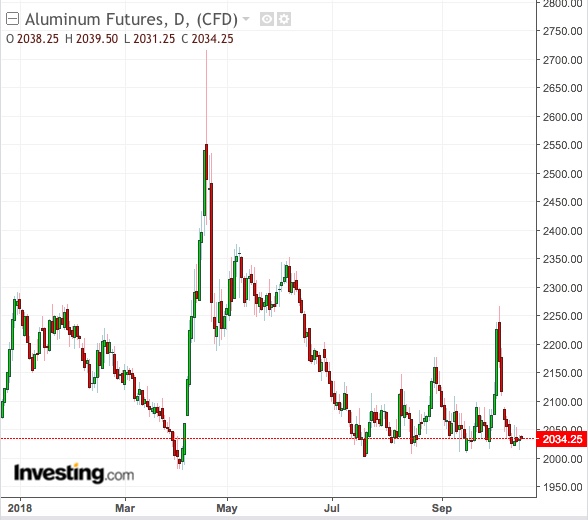Whether it’s used for manufacturing foil for sandwich wrappers or in the production of aircraft bodies, it’s the one metal business can’t do without. In fact, aluminum is such a ubiquitous raw material—tolerated well even by animals and plants—it’s hard to imagine life on earth without it.
Still, it’s one of this year’s least favored bets on the London Metal Exchange (LME), having spent seven out of ten in the red. It's now heading for its first annual loss in three years.

Aluminum’s weak prices are down to one single driver: US sanctions against Russian aluminum giant Rusal (MCX:RUAL) and its CEO Oleg Deripaska. The company is part of a broader group of Russian firms, businessmen and government officials sanctioned by the US Treasury Department in April for alleged meddling in the 2016 US presidential elections.
Sanctions Standoff To Extend Current Market Condition
The standoff over the sanctions—with Washington reaffirming Rusal’s and Deripaska’s guilt in the accusations leveled against them even as the two deny such involvement—is likely to drag out. Indeed, the Treasury last week pushed forward the expiration date for Rusal’s US-issued general licenses to November 12, in what was seen as a reprieve.
The deadline would also occur after the US midterm elections on November 6, buying time for the Trump Administration to avoid such hot-button issues before the polls.
In Tuesday’s trade, three-month aluminum futures on the LME settled a touch lower, at $2,032.75 a tonne, after a short-burst rally in three previous sessions following the deadline extension on Rusal's US licenses.
United Co. Rusal accounts for about 12 percent of all primary demand in the US, according to the Aluminum Association, and it's the second largest aluminum company by primary production output. When the Treasury first announced sanctions against Deripaska in April, aluminum buyers in the US initially raced to find replacement units.
Solid Fundamentals
The sudden squeeze on the global market caused a 12 percent rally on the LME in April—the biggest for aluminum in eight years. “Fundamentals remain solid,” Bank of America-Merrill Lynch said in a note this week on its outlook for the metal, noting that Rusal accounted for 6 percent of global production, aside from its commanding presence in the US market.
Yet the Wall Street bank acknowledged that aluminum prices remain “heavily influenced by a reluctance of market participants to take positions, as long as uncertainty persists over the fate of the company.”
“Indeed, any ruling on trade restrictions could be binary,” Bofa-ML said, referring to an outcome that would likely affect both the company and the aluminum market.
'Strong Sell' For Now; Year-End Pick-Up Possible
For the year, aluminum is down 10 percent. In 2017, it rallied an impressive 34 percent and in the previous year 11 percent.
Investing.com has a “Strong Sell” recommendation on the metal’s daily technical outlook, with a bear call on almost all of its daily-moving averages from the 10-day average of $2,060.47 to the 200-day average of $2,155.12.
However, CRU International, a global metals consultancy, has projected a base case scenario where aluminum could stabilize at $2,235 a tonne in the fourth quarter.
